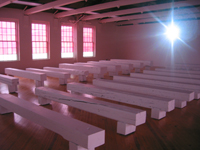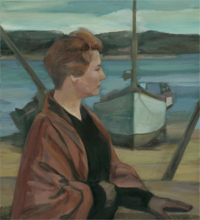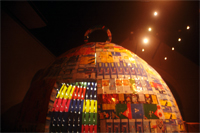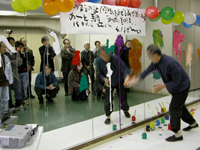Artists - H
|

|
Ann Hamilton (USA) 
Born in 1956 in Lima, Ohio, USA. Lives and works in Columbus,
Ohio.
Ann Hamilton studied textile design at the University of
Kansas after which she lived and worked in Banff and Montreal,
Canada until 1983. After her return to USA, Hamilton studied
sculpture at Yale University where she obtained a Master’s
Degree in Fine Arts. Hamilton’s focus on textiles and
fabric in her studies was not simply to master the medium
for creative
reasons – textiles and fabric have continued to be a major
source of inspiration in all of Hamilton’s art. Hamilton
taught
sculpture at University of California at Santa Barbara until
1991 but has since been focusing on her creative career.
She
represented the United States in the Sao Paolo Biennale in
1991 and the Venice Biennale in 1999 respectively, and is
known for work that skillfully utilizes vast spaces that
demands total sensory involvement.
Back to list
|
|

|
Karin Hanssen (Belgium) 
 Born
in 1960 in Antwerp, Belgium. Lives and works in Antwerp. Born
in 1960 in Antwerp, Belgium. Lives and works in Antwerp.
Born in 1960 in Antwerp, Belgium. Lives and works in Antwerp.
Karin Hanssen studied painting at the Antwerp Royal Academy
of Fine Arts and Higher Institute of Fine Arts, Antwerp.
Her paintings are based on the theme of “modern
life” as
reflected by the typical lifestyles of the middle classes
in the West and feature subject matter derived from various
print media and other source materials. Although Europe-based,
Hanssen has been selected to show at international exhibitions
such as the 7th Sharjah Biennale, 2005.
Hanssen’s paintings can be seen within the context of
post-modern “landscape paintings” in which realistic
natural landscapes began to be deconstructed. The lifestyles
depicted in these scenes began in the West but have spread
to Japan and other advanced economies around the world, resulting
in homogeneity from country to country. Her images comply
with certain ‘rules,’ using images from print
media, single frames from movies or TV commercials to bring
out images that have already been etched into our memories.
Back to list
|
|

|
Hedi Hariyanto (Indonasia) 
Born in 1962 in Malang, Indonesia. Lives and works in Jogjakarta.
Hariyanto creates sculpture-based installations utilizing
a range of different media, the theme of which is the political
and social contradictions found in modern society, with a
focus on the friction between existing values and the new
values emerging with the influx of consumer culture into Indonesia.
Hariyanto’s work is characterized either by the combined
use of different materials such as wood, water, metal and
plastic
or by the use of pamphlets. Major group exhibitions in recent
years include “The Landscape in Southeast Asian Art” (Singapore
Art Museum, 2000), “Imagining Jakarta” (Cemara
Gallery, Indonesia, 2004) and “Sculpture Expanded” (CP Artspace, Indonesia, 2005) while solo shows
include the
exhibition at Red Mill Gallery (USA, 2004).
Back to list
|
|

|
Sadaharu Horio + On-Site Art Squad «KUKI»
(Japan) 
Sadaharu Horio – Born in 1939 in Hyogo, Japan. Lives and
works in Kobe.
Joined the avant-garde artist group “Gutai Bijutsu
Kyokai (Gutai Art Association)” in 1966 which he participated
in until its disbandment in 1972. Horio has since continued
to be prolific, and since 1985 has been holding numerous solo
shows, group exhibitions and performances based on a single
and consistent theme of “Ordinary things.”
Horio’s art resonated with many artists, and the on-site
art squad «KUKI» – comprising dozens of
artists from the Kansai area – was formed by those supporting
Horio’s activity. Its first project – “KUKI Bijutsukan
in Hyogo Unga [Kuki Art Museum in the Hyogo Canal]” – was carried out in 2003, featuring a raft created from timber
left behind in what was once a timber yard. The floating “venue” created
by joining the timber together was used as an art museum where
installations and performances were held for the next year.
KUKI continues to hold group exhibitions as well as performances
both internationally and in Japan, especially in Kansai area.
Back to list
|
|